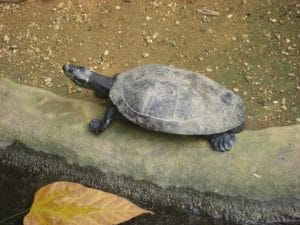Podocnemis erythrocephala (Red-headed River Turtle)
Home > Turtle Database > Podocnemis erythrocephala (Red-headed River Turtle)

Podocnemis erythrocephala, known for its striking red head, is a small freshwater turtle found in the Amazon basin. It lives mainly in blackwater rivers and has unique habits that set it apart from other South American turtles.
Native Turtle Species Map – Find Turtles by Region
Scientific Classification
Kingdom: Animalia
Phylum: Chordata
Class: Reptilia
Order: Testudines
Family: Podocnemididae
Genus: Podocnemis
Species: P. erythrocephala
Common Names
Red-headed River Turtle
Red-headed Amazon River Turtle
This Hilarious Turtle Book Might Know Your Pet Better Than You Do
Let’s be real—most turtle care guides feel like reading a textbook written by a sleep-deprived zookeeper.
This one’s not that.
Told from the snarky point of view of a grumpy, judgmental turtle, 21 Turtle Truths You’ll Never Read in a Care Guide is packed with sarcasm, sass, and surprisingly useful insights.
And hey—you don’t have to commit to the whole thing just yet.
Grab 2 free truths from the ebook and get a taste of what your turtle really thinks about your setup, your food choices, and that weird plastic palm tree.
It’s funny, it’s honest, and if you’ve ever owned a turtle who glares at you like you’re the problem—you’ll feel seen.
Identification
Description
This turtle is small, reaching up to 24 cm (about 9.5 inches) in length. It has a dark, oval carapace and a bright red or orange head, especially vivid in males. The plastron is lighter, often yellowish with some markings.
Sexual Dimorphism
Males are smaller and more brightly colored than females. They have longer, thicker tails and more intense red coloration on the head. Females are larger with shorter tails and duller head colors.
Check more turtles from the Podocnemis genus
Native Origin and Distribution
Geographical Range
Podocnemis erythrocephala is native to the Amazon Basin. It is mostly found in Brazil, Colombia, and Venezuela, especially in blackwater systems like the Rio Negro.
Preferred Habitat
This turtle prefers slow-moving blackwater streams, oxbow lakes, and flooded forest areas. It thrives in soft-bottom areas with leaf litter and submerged vegetation.
Behavior
Feeding Habits
It is omnivorous. Its diet includes aquatic plants, fruits, seeds, small invertebrates, and insects. Juveniles eat more animal matter, while adults eat more plants.
Predators
Eggs and hatchlings are vulnerable to birds, fish, and mammals. Adults may be hunted by caimans and humans.
Reproduction
Breeding Season
Mating usually occurs during the rainy season. Nesting follows in the dry season when river levels drop.
Reproductive Method
Females lay small clutches of 4–8 eggs in sandy or soft soil near water. The eggs incubate for several months, and hatchlings emerge with minimal parental care.
Conservation
Extinction Status
Listed as Vulnerable by the IUCN
Threats
Habitat destruction, pollution, and collection for the pet trade are major threats. Illegal harvesting of eggs and adults also contributes to population decline.
Conservation Measures
Some protected areas help safeguard this species. Research and awareness programs are ongoing, and captive breeding has been explored.
Economic Importance
Though small, the species is collected for the pet trade in some regions. It may also be hunted locally for food, though less commonly than larger turtle species.
Interesting Facts
The red head is not just for looks—it may help males attract females.
Unlike many turtles, this one prefers acidic blackwater rivers over clear or muddy ones.
Its eggs are especially sensitive to temperature changes, affecting hatchling sex.

About Author
Muntaseer Rahman started keeping pet turtles back in 2013. He also owns the largest Turtle & Tortoise Facebook community in Bangladesh. These days he is mostly active on Facebook.














